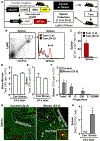Social Stress Mobilizes Hematopoietic Stem Cells to Establish Persistent Splenic Myelopoiesis
- PMID: 30485819
- PMCID: PMC6342493
- DOI: 10.1016/j.celrep.2018.10.102
Social Stress Mobilizes Hematopoietic Stem Cells to Establish Persistent Splenic Myelopoiesis
Abstract
Psychosocial stress accelerates myelopoietic production of monocytes and neutrophils that contributes to a variety of health complications ranging from atherosclerosis to anxiety. Here, we show that social stress in mice mobilizes hematopoietic stem progenitor cells (HSPCs) from the bone marrow that enter circulation, engraft into the spleen, and establish a persistent extramedullary hematopoietic depot. These splenic progenitors actively proliferate and differentiate into multiple cell types, including monocytes, neutrophils, and erythrocytes. Splenic erythropoiesis partially abrogates stress-induced anemia. Repeated injection with isoprenaline induces progenitor mobilization to the spleen, identifying a key role for β-adrenergic signaling. Moreover, protracted splenic production of CD11b+ cells persists for at least 24 days after the cessation of social stress. Thus, chronic stress establishes a persistent extramedullary hematopoietic depot that can modify a wide range of chronic disease processes and alter homeostasis of the bi-directional regulatory axis between the nervous and immune systems.
Keywords: extramedullary hematopoiesis; hematopoiesis; hematopoietic stem cells; myelopoiesis; spleen; stress.
Copyright © 2018 The Authors. Published by Elsevier Inc. All rights reserved.
Figures






Similar articles
-
Severe trauma and chronic stress activates extramedullary erythropoiesis.J Trauma Acute Care Surg. 2017 Jul;83(1):144-150. doi: 10.1097/TA.0000000000001537. J Trauma Acute Care Surg. 2017. PMID: 28452894 Free PMC article.
-
Promotion of Expansion and Differentiation of Hematopoietic Stem Cells by Interleukin-27 into Myeloid Progenitors to Control Infection in Emergency Myelopoiesis.PLoS Pathog. 2016 Mar 18;12(3):e1005507. doi: 10.1371/journal.ppat.1005507. eCollection 2016 Mar. PLoS Pathog. 2016. PMID: 26991425 Free PMC article.
-
E-Selectin Inhibition Mitigates Splenic HSC Activation and Myelopoiesis in Hypercholesterolemic Mice With Myocardial Infarction.Arterioscler Thromb Vasc Biol. 2016 Sep;36(9):1802-8. doi: 10.1161/ATVBAHA.116.307519. Epub 2016 Jul 28. Arterioscler Thromb Vasc Biol. 2016. PMID: 27470513 Free PMC article.
-
Roles of Hematopoietic Stem and Progenitor Cells in Ischemic Cardiovascular Disease.Curr Stem Cell Res Ther. 2021;16(5):589-598. doi: 10.2174/1574888X15666200130091858. Curr Stem Cell Res Ther. 2021. PMID: 32000654 Review.
-
Cholesterol efflux: a novel regulator of myelopoiesis and atherogenesis.Arterioscler Thromb Vasc Biol. 2012 Nov;32(11):2547-52. doi: 10.1161/ATVBAHA.112.300134. Arterioscler Thromb Vasc Biol. 2012. PMID: 23077140 Review.
Cited by
-
Renal denervation mitigates atherosclerosis in ApoE-/- mice via the suppression of inflammation.Am J Transl Res. 2020 Sep 15;12(9):5362-5380. eCollection 2020. Am J Transl Res. 2020. PMID: 33042425 Free PMC article.
-
Innate sensitivity to stress facilitates inflammation, alters metabolism and shortens lifespan in a mouse model of social hierarchy.Aging (Albany NY). 2019 Nov 9;11(21):9901-9911. doi: 10.18632/aging.102440. Epub 2019 Nov 9. Aging (Albany NY). 2019. PMID: 31707362 Free PMC article.
-
The Ontogeny of Monocyte Subsets.Front Immunol. 2019 Jul 17;10:1642. doi: 10.3389/fimmu.2019.01642. eCollection 2019. Front Immunol. 2019. PMID: 31379841 Free PMC article. Review.
-
15-PGDH inhibition activates the splenic niche to promote hematopoietic regeneration.JCI Insight. 2021 Mar 22;6(6):e143658. doi: 10.1172/jci.insight.143658. JCI Insight. 2021. PMID: 33600377 Free PMC article.
-
Review of Major Social Determinants of Health in Schizophrenia-Spectrum Psychotic Disorders: III. Biology.Schizophr Bull. 2023 Jul 4;49(4):867-880. doi: 10.1093/schbul/sbad031. Schizophr Bull. 2023. PMID: 37023360 Free PMC article.
References
-
- American Psychiatric Association; (2000). Diagnostic and Statistical Manual of Mental Health Disorders, Fourth Edition, Text Revision (American Psychiatric Association).
-
- Antoni MH, Bouchard LC, Jacobs JM, Lechner SC, Jutagir DR, Gudenkauf LM, Carver CS, Lutgendorf S, Cole SW, Lippman M, and Blomberg BB (2016). Stress management, leukocyte transcriptional changes and breast cancer recurrence in a randomized trial: an exploratory analysis. Psychoneuroendocrinology 74, 269–277. - PMC - PubMed
-
- Bailey MT, Kierstein S, Sharma S, Spaits M, Kinsey SG, Tliba O, Amrani Y, Sheridan JF, Panettieri RA, and Haczku A (2009). Social stress enhances allergen-induced airway inflammation in mice and inhibits corticosteroid responsiveness of cytokine production. J. Immunol. 182, 7888–7896. - PMC - PubMed
Publication types
MeSH terms
Substances
Grants and funding
LinkOut - more resources
Full Text Sources
Other Literature Sources
Medical
Molecular Biology Databases
Research Materials

